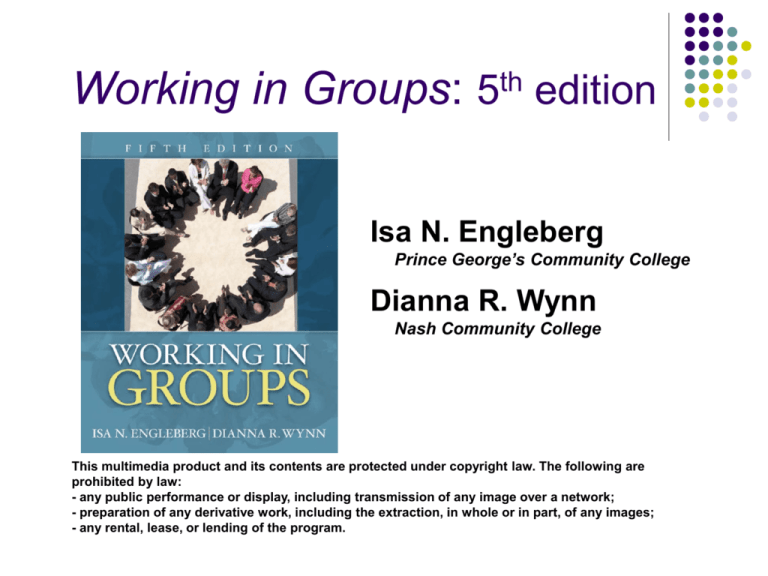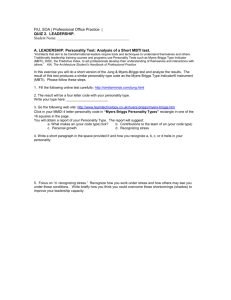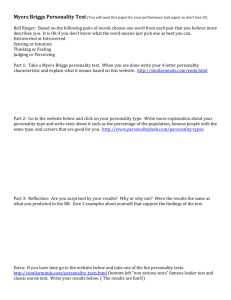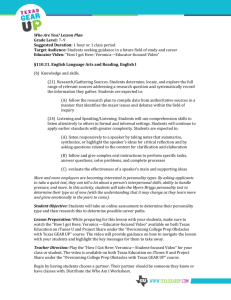Chapter 3: Group Member Diversity
advertisement

Working in Groups: 5th edition Isa N. Engleberg Prince George’s Community College Dianna R. Wynn Nash Community College This multimedia product and its contents are protected under copyright law. The following are prohibited by law: - any public performance or display, including transmission of any image over a network; - preparation of any derivative work, including the extraction, in whole or in part, of any images; - any rental, lease, or lending of the program. Chapter 4: Group Diversity Definition of Culture A learned set of shared interpretations about beliefs, values, and norms which affect the behaviors of a relatively large group of people Myron Lustig and Jolene Koester Intercultural Competence: Interpersonal Communication across Cultures Co-Culture A group of people who coexist within the mainstream society, yet remain connected to one another through a common cultural heritage Co-Culture Examples Native American African American Italian American Example: __________________ Example: __________________ Example: __________________ Three Layers of Diversity PowerPoint Quiz A. Ethnocentrism B. Stereotyping C. Prejudice D. Discrimination __ Generalizations about a group of people that oversimplify their characteristics __ Negative attitudes and beliefs about others based on faulty or inflexible beliefs __ A belief that your culture is superior to other cultures __ Actions that exclude certain people from opportunities granted to others Barriers to Understanding Ethnocentrism Example: _________________________ Stereotyping Example: ___________________________ Prejudice Example: _________________________ Discrimination Example: _________________________ Big Five Personality Traits Extraversion Agreeableness Introversion Disagreeableness Conscientiousness Carelessness Emotional Stability Neuroticism Openness to Experience Closed to Experience Myers-Briggs Personality Types Myers-Briggs Type Indicator® (MBTI) Helps explain why group members think and interact in different ways Examines how members use their minds to perceive the world and make decisions Divides preferences of thought and behavior into four dialectic categories Myers-Briggs Categories Extrovert Introvert Sensor Intuitive Thinker Feeler Judger Perceiver Myers-Briggs Implications Groups are more successful when all personality types are represented. Understanding personality types helps a group: capitalize on differences in personality styles and preferences. foster group productivity and cohesiveness. Match the Personality Traits ___ Extrovert ___ Introvert ___ Sensor ___ Intuitive ___ Thinker ___ Feeler ___ Perceiver ___ Judger A. Objective and fair B. Well organized C. Tenderhearted and tactful D. Theoretical E. Reserved and private F. Talks first, then thinks G. Practical and realistic H. Goes with the flow PowerPoint Quiz Reggie likes to coordinate the group’s work and keep it organized. He never misses a deadline and expects others to do the same. Which Myers-Briggs personality trait best describes Reggie? a) Sensor b) Judger c) Intuitive d) Perceiver e) Thinker Cultural Dimensions Geert Hofstede: Four Cultural Dimensions: 1. 2. 3. 4. Individualism and Collectivism High and Low Power Distance High and Low Uncertainty Avoidance Masculine and Feminine Values Edward T. Hall: Two Cultural Dimensions: 1. 2. High and Low Context Monochronic and Polychronic Time Individualism-Collectivism Individualism: Emphasizes the independence and individual achievement United States, Australia, Canada Collectivism: Emphasizes the needs and goals of the group, rather than the individual Asian and Latin American countries Power Distance High power distance: Accepts differences in power as normal Assumes all people are not created equal Mexico, India, Singapore Low power distance: Power distinctions are minimized New Zealand, Denmark, Israel Uncertainty Avoidance High uncertainty avoidance: Uncomfortable in unstructured and unpredictable situations “What is different is dangerous.” Prefer rules, plans, routines Japan, Belgium, Greece Low uncertainty avoidance: Comfortable with ambiguity and unpredictability “What is different is interesting.” Can work independently without supervision Jamaica, Hong Kong Masculine-Feminine Values Masculine Value Societies: Men are assertive, tough, and ambitious Women are modest, tender, and focused on the quality of life Japan, Venezuela, Italy Feminine Value Societies: Gender roles overlap Men and women value tenderness and care about the quality of life Sweden, Norway, Denmark High context-Low context High-context Culture: Meaning is communicated through nonverbal behavior and the nature of interpersonal relationships Messages are implied and context sensitive Japan, China, Greece, Mexico Low-context Culture: Meaning is expressed primarily through language Messages are direct, factual, and objective England, United States, Germany Monochronic Time and Polychronic Time Monochronic time: Events are scheduled as separate items, one thing at a time Time is valuable; schedule and deadlines are important North America, Northern Europe Polychronic time: Schedules are not very important, deadlines are missed, interruptions are tolerated Kenya, Argentina For Women: How to Adapt to Male Group Members Don’t expect or force men to talk about or display their emotions. _______________________________ _______________________________ Let men know that you appreciate their objective analysis and detachment. For Men: How to Adapt to Female Group Members Don’t use sarcasm or tell women they’re illogical. ________________________________ Don’t worry about being unkind if you disagree a man. ________________________________ Generational Dimensions Traditionalists: 1900-1945 Baby Boomers: 1946-1964 Generation Xers: 1965-1980 Millennials: 1981-1999 Working with Baby Boomers Respect Baby Boomers and acknowledge their experience. Communicate face-to-face rather than relying totally on email. ________________________________ _ ________________________________ _ Working with Generation Xers Get to the point and state your objectives. Avoid micromanaging Generation Xers. ________________________________ ________________________________ ________________________________ ________________________________ Religious Literacy The ability to understand and use the religious terms, symbols, images, beliefs, practices, scripture, heroes, themes, and stories that are employed in American public life True or False about Religions True or False: ___ Christianity is older than Islam. ___ Jews celebrate Christmas and Easter. ___ Hinduism is older than Buddhism. Add your own true/false statements: ___ _____________________________ ___ _____________________________ Adapt to Religious Dimensions How do the needs, attitudes, and practices of others’ religions affect the group’s work? What adaptations, if any, should you make to accommodate the religious practices or beliefs of other members? Essay Questions The Golden Rule—“Do unto others as you would have them do unto you”— may not work in groups with diverse members. • Why is this true? • What strategies can help you learn more about different cultures?







